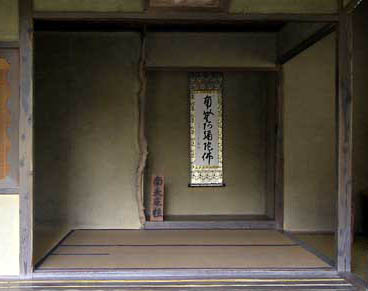 Decorative alcove
Decorative alcove
A feature of tea house design that maintained its early link with Zen Buddhism was the decorative or picture alcove (tokonoma), where the host might place a single flower arrangement and hang a scroll (kakemono) with a thematic poem or haiku. The alcove would usually be wider than it was deep and have a slightly raised floor.
Preparation area
Larger tea houses would typically also have a small preparation room (mizuya). Smaller huts would usually just have a small alcove with shelves to hold utensils.
Fire pit
The charcoal fire pit (ro) in a tea hut was typically around 40cm square and sunk into the floor by cutting away part of the tatami (or by using a shorter daime tatami). An iron kettle was suspended by a chain from the ceiling and there was a wooden cover when not in use.
Screens
The sliding paper screens called shoji were more of a feature of the shoin-style tea room than the sōan-style tea hut, but could and can be used with good effect for internal divisions.
start page